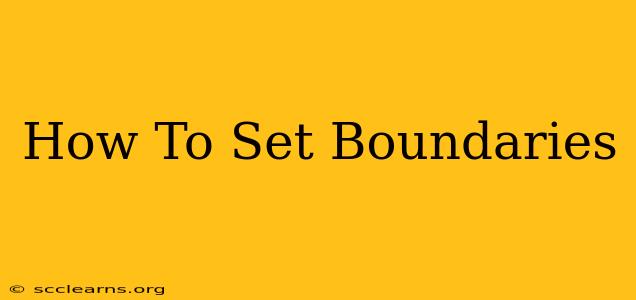Setting boundaries can feel daunting, like navigating a minefield of potential conflict. But the truth is, establishing healthy boundaries isn't about being selfish; it's about self-preservation. It's about respecting yourself and your needs, leading to a more fulfilling and less stressful life. This guide will help you understand why boundaries are essential and provide practical steps to implement them effectively.
Why Setting Boundaries is Crucial for Your Well-being
Many people struggle with setting boundaries due to ingrained beliefs about being "nice" or fearing conflict. However, the long-term consequences of not setting boundaries far outweigh any short-term discomfort. Consider these key benefits:
- Reduced Stress and Anxiety: Constantly saying "yes" when you mean "no" leads to burnout and resentment. Boundaries protect your mental and emotional energy.
- Improved Relationships: Ironically, clear boundaries strengthen relationships by fostering respect and understanding. People are more likely to value you when they know your limits.
- Increased Self-Esteem: Asserting your needs demonstrates self-respect and confidence. It empowers you to prioritize your well-being.
- Enhanced Productivity and Focus: When you protect your time and energy, you have more resources to dedicate to things that truly matter.
- Greater Sense of Control: Setting boundaries gives you a sense of control over your life, reducing feelings of helplessness and overwhelm.
Identifying Your Needs and Limits: The First Step
Before you can set boundaries, you need to understand your own limits. Ask yourself:
- What drains your energy? Identify activities, people, or situations that consistently leave you feeling depleted.
- What are your non-negotiables? These are the things you absolutely will not compromise on.
- What are your values? Your boundaries should reflect your core values and beliefs.
- What are your priorities? Focus on protecting time and energy for what matters most to you.
Journaling can be a powerful tool in this process. Spend some time reflecting on past experiences where you felt overwhelmed or resentful. What could you have done differently?
Setting Boundaries: Practical Tips and Techniques
Now that you've identified your needs and limits, it's time to put your boundaries into action. Here are some practical techniques:
1. Learn to Say "No" (and Mean It!)
This might seem simple, but it's often the hardest part. Practice saying "no" to requests that don't align with your priorities or values. Don't feel obligated to offer lengthy explanations. A simple "No, thank you," or "I'm not available," is often sufficient.
2. Communicate Your Needs Clearly and Directly
Use "I" statements to express your feelings and needs without blaming others. For example, instead of saying "You always interrupt me," try "I feel frustrated when I'm interrupted. Could you please let me finish my thought?"
3. Be Consistent
Consistency is key. If you set a boundary and someone violates it, gently but firmly remind them of your limit. Don't be afraid to enforce consequences if necessary.
4. Practice Self-Compassion
Setting boundaries isn't always easy, and there will be times when you stumble. Practice self-compassion. Forgive yourself and learn from your mistakes.
5. Seek Support
If you're struggling to set boundaries, don't hesitate to seek support from a therapist, counselor, or trusted friend or family member.
Maintaining Your Boundaries: Ongoing Effort and Adjustment
Setting boundaries is an ongoing process, not a one-time event. You may need to adjust your boundaries over time as your needs and circumstances change. Be prepared to revisit and refine your boundaries as needed. Remember, self-care is not selfish; it's essential. By setting healthy boundaries, you're investing in your well-being and creating a more fulfilling life.

